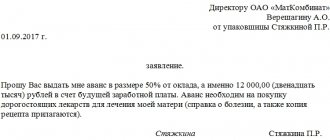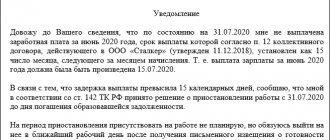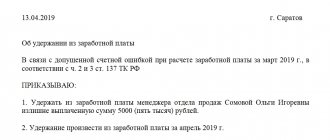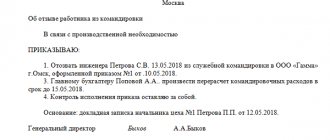According to Central Bank Directive No. 3210-U, an employee who has received money for reporting must report on it within three working days after:
- the day of expiration of the period for which the report was issued;
- return to work if the return date occurred during the employee’s absence due to a business trip, illness, or vacation.
In the practice of working with accountable employees, there are often situations when an employee, having received an accountable advance, reports for a smaller amount, or does not submit an advance report. In this situation, the employee must return the unspent advance.
What an accountant needs to remember when issuing money for reporting
The issuance of money on account is regulated by the instruction of the Bank of the Russian Federation dated March 11, 2014 No. 3210-U, which establishes the procedure for conducting cash transactions (hereinafter referred to as procedure No. 3210-U). Based on its provisions, there are 3 main points that every accountant needs to remember when issuing money for reporting:
- Accountable funds are issued on the basis of a written application from the person receiving the funds or an order from the manager. The required details of such an application include (except for the full name, position and signature of the applicant): the amount of accountable funds, the period for which the money is issued, the date and signature of the manager who authorized the release of funds into account (clause 6.3 of order No. 3210- U). A sample application can be viewed on our website.
ATTENTION! From November 30, 2020, an administrative document can be drawn up for several cash payments to one or more employees. In this case, you need to indicate the name, amount and period for which the money is issued for each employee.
What other innovations in the procedure for recording cash transactions have come into effect, ConsultantPlus experts told. Get trial access to the K+ system and go to the review material for free.
2. The deadlines for issuing money for reporting may be established by accounting policies or a separate order. This will make it easier for accountable persons to write statements, and for an accountant to check the timing of refunds. Legislatively, there are no established boundaries for the periods for which money is issued for reporting purposes. Each enterprise resolves this issue independently.
IMPORTANT! The enterprise must have an order stating who has the right to receive money on account. We have a sample of such an order on our website.
- The accountable person is obliged to report the accountable amount or return unused funds to the enterprise's cash desk within the number of days established by the employer after the end of the period for which he was given the money. If the money was issued for a business trip, the accountable person is obliged to report within the period established by the employer after returning.
Another important nuance is the maximum possible amount that can be reported. This has its limitations.
We recommend that you look at the material “What amount can be issued for reporting in 2021 - 2021?”
Deduction amount
Thus, the employer has the right to withhold from wages an accountable amount that was not spent by the employee. The deduction is made through an application by the employee or by order by order of the employer.
In any case, you must obtain consent from the employee to withhold, otherwise the debt can only be recovered through legal proceedings. A debt on accountable amounts is incurred by an employee if he does not provide an advance report within 3 days after starting work or the amount on the report is less than what was issued to him.
How an accountable person must report
To write off money received from an employee, there is a prescribed form called an “Advance report”. The advance report form (AO) in the columns on the expenditure of amounts is filled out by the accountable person independently. The JSC is accompanied by primary documents confirming the fact of expenditure.
For a sample of filling out an advance report, see here.
In the corresponding columns of the table on the reverse side of the JSC form, the accountable person indicates:
- serial number of the record;
- date of expenditure of funds (issue of the primary document);
- number of the primary document;
- name of the primary document;
- amount of expense.
If daily expenses that do not have primary documents are written off, the date of the expense is indicated and the daily allowance approved by the enterprise is entered. You should also indicate the number of the order on the basis of which the daily allowance was issued to the business traveler.
In the final line of the form, the accountable person enters the amount of funds spent. The accountant checks the correspondence of the amount in the report with the amount of funds received by the accountable person.
If the amount on the advance report is greater than what was issued to the accountable person, then an additional payment is made to the accountable person from the cash desk of the enterprise or (at his request) to a bank card.
How to do this correctly, see here “Transferring a sub-report to an employee’s card from a current account.”
If the amount of funds written off according to the advance report is less than what was issued to the accountant, he is obliged to return the remaining money to the enterprise. If the accountable person does not return the balance of unspent (not written off according to the advance report) funds or does not report within the specified time frame, he or she becomes indebted to the enterprise for the amounts received in the account.
Accounting and tax accounting
The employee's debt for accountable funds is his obligation to the employer. The amount may be transferred to the income category if the company’s management decides to forgive the debt.
After the period of pre-trial settlement of the problem (1 month), insurance premiums are charged on the amount of debt. The amount of contributions can be offset or refunded if one of the conditions is met:
- the employee voluntarily returned the funds;
- the amount of debt was counted as expenses on the basis of an advance report and documents confirming the targeted nature of the expenses.
There are two ways to write off debt from dismissed employees:
- through spending part of the reserve for doubtful debts;
- through attributing the amount of debt to financial results.
Expert opinion
Kostenko Tamara Pavlovna
Lawyer with 10 years of experience. Author of numerous articles, teacher of Law
In the first case, a posting is made between the debit of 63 and the credit of 71 accounts, in the second, the debit turnover is recorded for 91 accounts, and the credit entry is recorded for 71 accounts. Simultaneously with these correspondences, the amount is reflected in off-balance sheet accounting in account 007.
In off-balance sheet accounting data, information about written-off bad debts of this type must be displayed for 5 years from the date of closure of the debt.
Methods of deduction of funds from wages and standard entries for repayment of accounts
There are 3 possible scenarios:
- The accountable person acknowledges the debt and writes an application to withhold funds received on account for which he owes money from his salary.
- The employer retains the debt of the accountable on his own initiative. This situation, in turn, suggests 2 possible scenarios:
- when the reporting person does not dispute the debt, the enterprise, within a month from the end of the deadline by which the employee was supposed to report, may decide to withhold the money;
- when the accountable person does not agree with the fact of the debt, only the court can make a decision to withhold money.
- The manager decided to forgive the debt to the accountable person.
In the first case, when the accountable person acknowledges the debt and writes an application with a request to withhold the accountable money from his salary, the entire amount of the debt can be withheld at a time, unless otherwise indicated in the application for withholding (letter of Rostrud dated September 26, 2012 No. PG/7156-6- 1).
In the second case, when the accountant does not dispute the fact of the debt, the accountant has the right to withhold the debt from the employee. To do this, it is necessary to make a decision (issue an order) to withhold the debt within a month from the date set for submitting the advance report to the accounting department or returning the imputed amounts. The order must include the signature of the employee, indicating that he has no objections. This norm is established by Art. 137 Labor Code of the Russian Federation.
Important! ConsultantPlus warns that the maximum amount of deductions from an employee’s salary is 20% of the accrued amount minus personal income tax (Article 138 of the Labor Code of the Russian Federation, Letter of the Ministry of Health and Social Development of Russia dated November 16, 2011 N 22-2-4852). Therefore, if the unreturned accountable amount exceeds 20% of the accrued salary minus personal income tax, then... See K+ for more details. Trial access is available for free.
Here are typical transactions for the operations discussed above:
| Dt | CT | Operation description |
| 71 | 50 | Issuance of cash from the company's cash desk |
| 94 | 71 | Reflects debt on unreturned accountable funds |
| 20–44 | 70 | Employee's salary accrued |
| 70 | 68 | Personal income tax withheld from salary |
| 70 | 94 | Employee debt repaid |
In the case where the accountable person disputes the debt, only the court can resolve the issue. At the same time, after a month from the last reporting date, the accountant is obliged to accrue additional insurance premiums for the amount of unreturned accountable funds (Articles 7, 8 of Law No. 212-FZ dated July 24, 2009). As for personal income tax, it is accrued upon the fact that the debt is written off in connection with a court decision (if the court made a decision in favor of the employee) or on the date the debt is forgiven.
Debt forgiveness is the last possible development of events in the event of non-repayment of accountable amounts. If a decision is made to forgive the debt of an accountable person, it is necessary to issue an appropriate order (you can also limit yourself to receiving the appropriate resolution from the manager on the accountable person’s application to forgive his debt).
The date of the resolution (or order) is considered the date the debt is written off from the debtor (clause 2 of Article 415 of the Civil Code of the Russian Federation).
Whether the written-off debt of an accountant is subject to personal income tax and insurance premiums and what to do with income tax, find out in the Ready-made solution from ConsultantPlus by getting trial access to the system for free.
Postings when forgiving a debt on an unreturned account look like this:
| Dt | CT | Operation description |
| 91 | 71 | Debt written off based on order |
| 70 | 68 | Personal income tax withheld from the amount of the written off debt |
| 91 | 69 | Contributions accrued on written-off debts |
Is the employee’s consent required to withhold an accountable amount?
An employee can return unspent funds in cash and deposit them into the company’s cash desk. But if he does not have the opportunity to repay the debt on time, then several options are allowed for deducting it from his salary.
Labor Code in Art. 137 provides for the employer’s right to return unspent accountable amounts. Refunds are available in several options:
- At the request of the employee . In this case, the employee writes a free-form application addressed to the employer, where he asks to withhold accountable amounts from his income.
- By decision of the employer through the issuance of an order to withhold accountable amounts from the employee.
Regardless of the method of returning the accountable amount, consent to the withholding must be obtained from the employee. Otherwise, according to the provisions of Art. 137 of the Labor Code and according to the explanations of Rostrud of 2007 No. 3044-6-0, the only way to collect debt is to go to court.
It is impossible to obtain accountable amounts by order without the prior consent of the employee. The employee’s consent to withholding must be obtained in writing so that regulatory authorities do not have a reason to hold the employer liable.
Consent may take the form of a statement from the employee, or he may sign the order to withhold the accountable amount and indicate there that he does not dispute the grounds for the withholding and the amount of the debt.
The employer can also provide the employee with a preliminary written notice of the amount of the upcoming deduction, where he must sign.
Also in practice, the following scenarios are possible:
- If there is a disagreement between the employer and the employee regarding the amount of debt, or the employee refuses to return the money voluntarily, then the employer must go to court . In this case, the limitation period for debt collection is three years.
- Company management may decide to write off debt by recognizing it as employee income . It is important to consider that this amount will become taxable income and personal income tax must be transferred from it from unused accountable amounts. Forgiveness of debt to an employee is formalized through the issuance of an appropriate order.
Results
When issuing imprest amounts, the enterprise accountant is obliged to keep records of the timing of their return. If the accountable does not timely report for the amounts issued (or does not return them), it is possible to deduct them from the salary. The procedure for such retention can be initiated by both the employee and the employer.
More information about how to collect a report from the director of an enterprise can be found in the article “Five effective ways to reset the accumulated report of a director.”
You can find more complete information on the topic in ConsultantPlus. Free trial access to the system for 2 days.
Foundation documents
The primary document by which the employee’s debt for accountable amounts to the enterprise is revealed is the advance report of form No. AO - 1, approved by the employer.
It reflects the amounts issued to the employee and documented expenses.
However, it is impossible to collect a debt from an employee only on the basis of an advance report.
For this purpose, based on the written consent of the employee, an order is issued to withhold unspent accountable amounts from the salary.
This will be the basis for collecting the amount of the debt.
If the employee does not give consent and no agreement is reached, then the employer needs to file a lawsuit.
Then the document - the basis will be an executive document: a court order or a writ of execution.
However, at least a month and a half will pass before such a document is received, during which time the employee may have time to resign.
Then the collection will no longer be handled by the employer, but by the bailiff - the procedure for withholding is by order of the bailiffs.
Upon dismissal
Sometimes, at the time of dismissal, an employee has an outstanding amount of accountable amounts.
If the employee’s consent to withhold has already been taken, and an order for the enterprise has been issued, a recovery of no more than 20% is also made from the calculated amounts.
The employee can voluntarily deposit the balance of the debt into the company's cash desk upon receipt of the payment upon dismissal.
To do this, the accountant prints outgoing and incoming cash orders at the same time.
When the amount of debt is revealed immediately at the time of dismissal, the employer must follow the same course of action as with a working employee.
If an employee does not want to pay the outstanding amount, the employer does not have the right to delay his dismissal.
He can collect the amount of the debt after it has been settled.
To do this, you must first submit a statement of claim to the court, then with a court order to the bailiffs.
Consequences of non-return
Accountable funds that the subordinate did not return in a timely manner should be reflected as his debt to the company before the expiration of the statute of limitations in accordance with Article 196 of the Civil Code of the Russian Federation. They are not the employee’s income and are not subject to personal income tax. Personal income tax should be calculated and withheld in the following cases:
- forgiveness of debt to an employee for unrepaid amounts;
- expiration of the statute of limitations for collection of funds.
But if a subordinate does not return unspent funds for a long time, does not provide documents confirming expenses, and the company does not take any action to collect the employee’s debt, then with a high degree of probability the inspection authorities will recognize this debt as the employee’s income and charge personal income tax (clause 8 of the Federal Tax Service letter dated 12/24/2013 No. SA-4-7/23263).
To avoid claims from tax authorities, you should carefully monitor the correctness of transactions with employees regarding the money issued.







